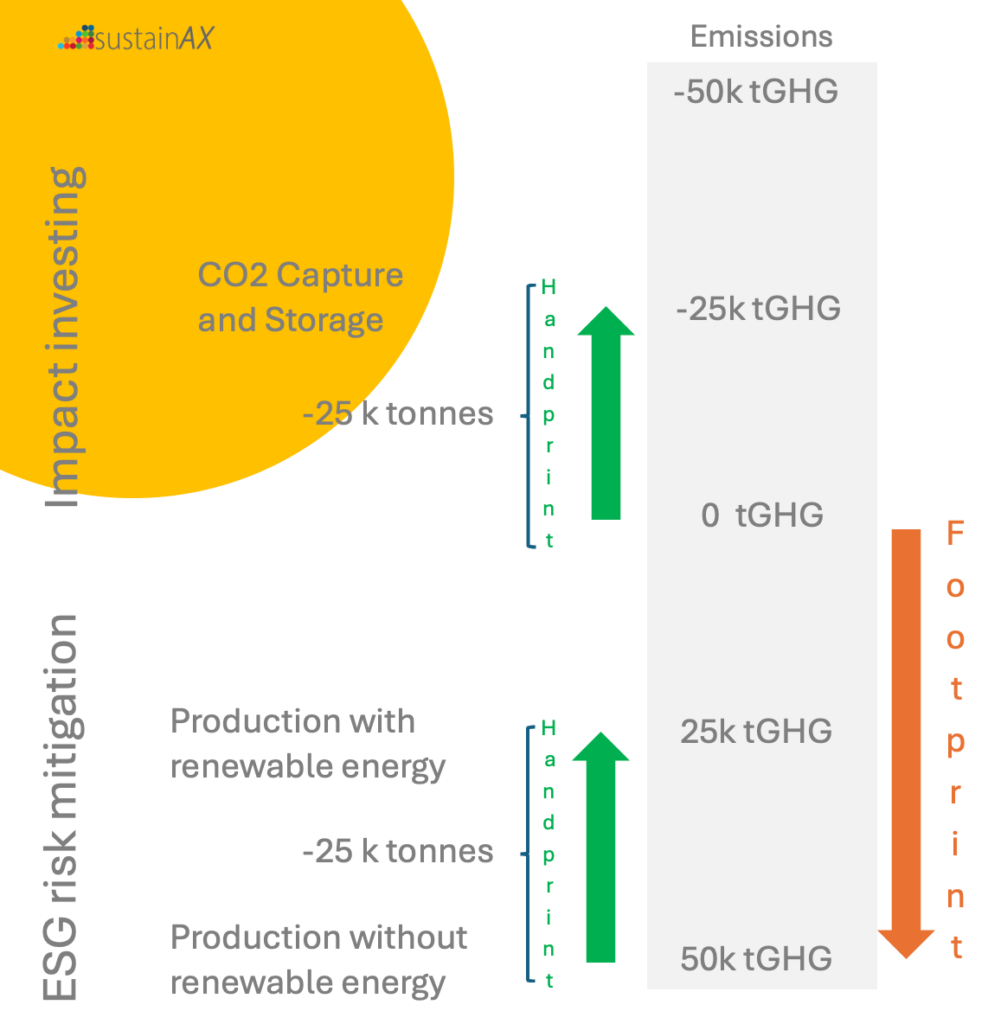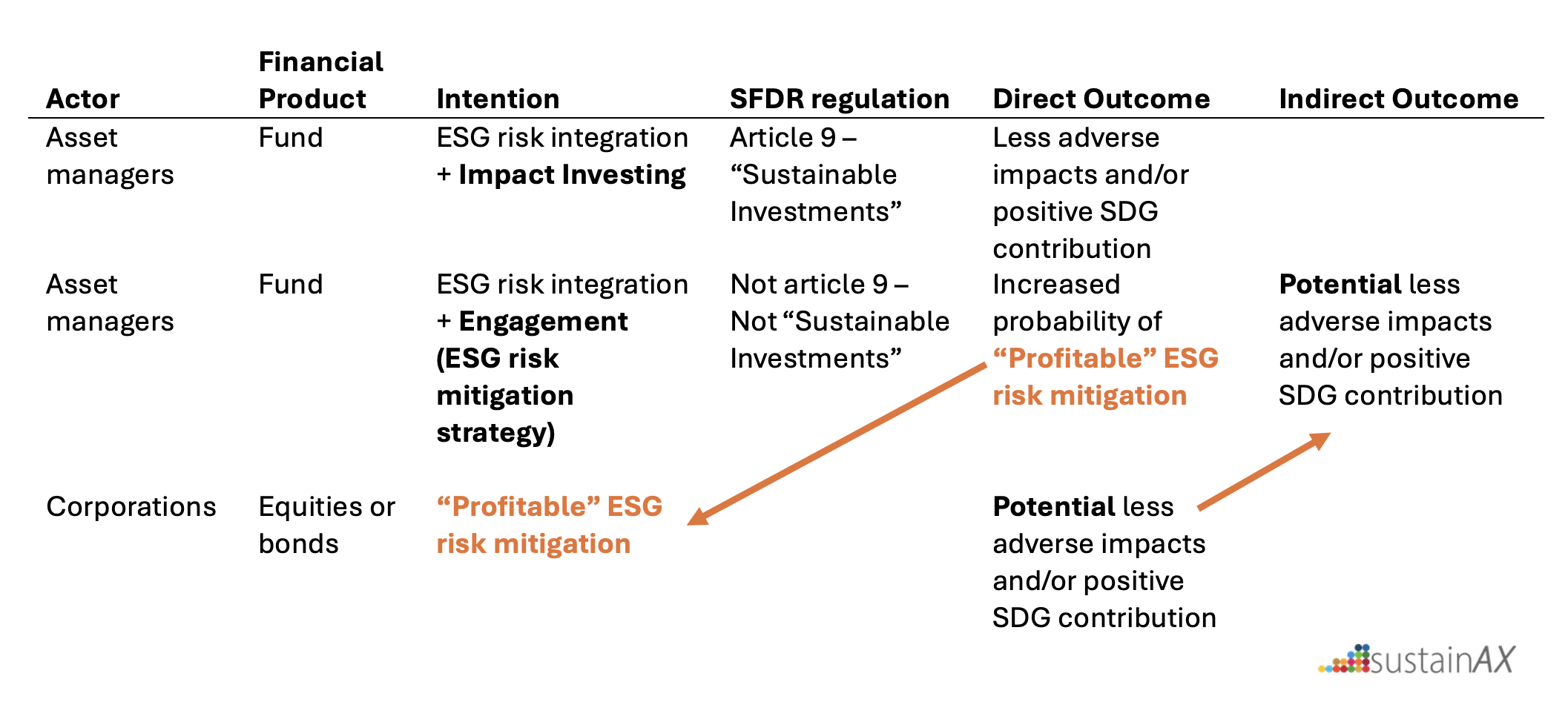ESG risk mitigation strategies have more impact than impact investing
Corporates will only move when expected risk adjusted returns are under threat or can improve
Impact investing, here assimilated to Sustainable Investments as per SFDR 2(17), and ESG risk mitigation strategies can contribute to the same environmental and social goals, but the intentions and mechanisms to get there is not the same. This is one of the reasons there is so much confusion around this and many mix up ESG risk mitigation and impact investing strategies and call it all for “ESG investing”. Let’s try to clear this out.
Impact investing versus ESG risk mitigation
Characteristics of Impact investing
Impact investing starts with an intention to have a positive impact on environmental and social goals. The real impact investor is ready to forsake risk adjusted financial returns, but not risk adjusted returns including the intended environmental and/or social impact. Of course, it is hard to get impact returns and financial returns into the same scale, but on a principal level the total counts for impact investors. From one strategy to another, the weight of the non-financial returns in the targets can vary a lot, from close to zero to anthropology where no financial return is targeted. This can at times make it hard to know what you are buying as an asset owner.
Claiming that real impact investing does not forsake expected risk adjusted financial returns does not make sense, all positive impact carry a cost. Assets under management in impact strategies would be dominant if returns were expected to be the same as for equivalent non-impact strategies and topped with environmental and/or social returns. More is always better in the financial world, right?
Contributions to environmental and social goals are often proxied into “SDG contributions”.
Characteristics of ESG risk mitigation strategies
Let us first distinguish between ESG risk integration and ESG risk mitigation.
Investors must do ESG risk integration in actively managed strategies, that implies they must have access to ESG risk research of companies to understand the ESG risks and work out what it can mean financially. What financial impact if it happens, probability of it happening and horizon? This should be integrated in valuation models and that way have an impact on investment decisions over time. As investors start realising what ESG risks they are exposed to, the practice of ESG risk mitigation strategies will increase.
Only companies can do “real” ESG risk mitigation through action on the ground. Of course, a portfolio manager can have an ESG risk mitigation strategy, i.e. to reduce portfolio ESG risk levels. The investor can put pressure on companies to mitigate their ESG risks through engagement and that way reduce ESG risk of the portfolios. Some of the ESG risks can be found among the SFDR Principal Adverse Impacts (PAI), but there are of course many other ESG risk areas to consider within a materiality context.
The main difference between impact investing and ESG risk mitigation strategies – The intentions
While impact investing has an intention to contribute positively to environmental and social goals in addition to financial returns, ESG risk mitigation strategies have an intention to reduce ESG risk and that way increase risk adjusted returns. These to types of intentions live in different universes and must not be mixed up. The first is focusing on the society at large and the second on the long-term viability and profitability of the business model. Some asset managers and companies play on non-transparency here, pretending having the impact intention while in reality having the ESG risk mitigation intention and this adds to the “ESG investing” confusion. An example is companies claiming they have a strategy to contribute to SDGs and not stating this is actually a side-effect of ESG risk mitigation. The board of directors see improved expected risk adjusted financial returns, while the marketing department see an intention to do good. As ESG risk analyst, we see this all the time.
Where impact investing and ESG risk mitigation strategies can meet – The outcomes
Despite having different intentions, impact investing and ESG risk mitigation strategies can meet in outcomes. When impact strategies work to increase or maintain their positive impact or “handprint”, ESG risk mitigation strategies work to reduce their “footprint” from adverse impact created by their activity (inside-out) and potential costs from global megatrends (outside-in). The “handprint” and the “footprint reduction” (also a “handprint”) are in many cases working on the same scale but in different parts, but their contributions can be in the same direction and hence their contribution as such could be “the same”. Let us look at some simple examples.
Example 1 – GHG emissions
Impact strategy
*Intention: Investing in a high-risk CO2 capture facility that non-impact investors will not invest in as the expected risk adjusted returns are “too low”.
*Impact: Less GHG in the atmosphere -> Less global warming
ESG risk mitigation strategy
*Intention: Engage to make companies reduce business model risk from GHG emissions in production as it can lead to high costs in the future and/or lower sales as clients are seeking more environmentally friendly products.
*ESG risk mitigation: Changing to renewable energy to reduce the GHG intensity for the products.
*Impact: Less GHG emissions to the atmosphere -> Less global warming
Illustration 1 – Example 1 – GHG emissions

Example 2 – Water scarcity for local communities
Impact strategy
*Intention: Investing in water cleaning facilities in emerging countries where mining and production plants are emptying and polluting ground water reserves hindering local communities having access to abundant and clean water. Risk adjusted returns are considered too low for non-impact strategies.
*Impact: More clean water available for the local community
ESG risk mitigation strategy
*Intention: Engage to make companies reduce business model risk from water scarcity and water pollution from production. Clients may turn away from their products or they may lose permission to operate.
*ESG risk mitigation: Changing production’s use of water by reusing it and cleaning it when changed with new water. Alternatively move production (example dying) to a less water scarce region.
*Impact: More clean water available for the local community
Example 3 – Regenerative agriculture
Impact strategy
*Intention: Investing in projects with practice of regenerative agriculture to increase sustainable food production. Risk adjusted returns are considered too low for non-impact strategies.
*Impact: SDG 2.4 – Zero Hunger, KPI 2.4.1 – Increase proportion of agricultural area under productive and sustainable agriculture
ESG risk mitigation strategy
*Intention: Engage to make companies reduce the risk of operations in non-regenerative agriculture as the consumer preferences may change towards regenerative agriculture products and as the regulatory environment may increase costs for non-regenerative agriculture products.
*ESG risk mitigation: Increase use of regenerative agriculture practices.
*Impact: SDG 2.4 – Zero Hunger, KPI 2.4.1 – Increase proportion of agricultural area under productive and sustainable agriculture
Of course, this is stylistic to simplify, even impact strategies must do ESG risk integration and very often they also practice engagement with companies to make them mitigate ESG risks as all activities have some “footprint”. No doubt it can be a little blurry and the difference in intention can easily be forgotten.
What works – Corporates will only move when risk adjusted returns are under threat or can improve
Only corporates can do “real” ESG risk mitigation and only ESG risk mitigation where the cost of the risk mitigation is less than the gain (higher revenue, lower costs, lower risks) will be addressed for most of them as this is what the board and management is limited to do according to the corporate statutes combined with the directors’ fiduciary duty (including duty of loyalty and duty of care). We can call this “profitable” ESG risk mitigation.
Therefore, the better companies understand their ESG risks, the more “profitable” ESG risk mitigation can be, as for most companies the ESG risk is probably higher than understood. ESG risk research plays a crucial role to the difference of sustainability reporting here as the ESG risk level must be assessed and understood before companies will react.
Conclusion
Not only impact investing has positive impact on environmental and social goals, ESG risk mitigation strategies can also have positive impact.
On one hand, companies’ board of directors or C-suite members do not have the permission to spend company resources on a program that is not intended to increase sales, reduce costs, or reduce risk unless explicitly stated in the company statuses. Therefore, calling out companies asking for anthropology, or “unprofitable” ESG risk mitigation is not productive. It is waste of time.
On the other hand, “profitable” ESG risk mitigation is something companies do understand, and it is within their mandate. Therefore, focus should be on helping companies understand the full environmental and social cost of their activities and the resulting ESG risk aspects, and here investors have a role to play through engagement. This will lead to ESG risk mitigation with, in many cases, positive impacts on the environmental and social goals, like the SDGs, but only as an unintended side-effect. Companies and investors should be transparent about the latter!
Table 1 – How impact investing and ESG risk mitigation (Engagement) strategies can meet in Outcomes despite very different Intentions

Global assets under management with ESG risk integration is massive compared to impact strategies, therefore engagement leading to ESG risk mitigation have more total absolute impact than impact investing! An assumption here is that proper ESG risk integration processes are in place and well executed, this is likely not yet the case globally, but will be.




